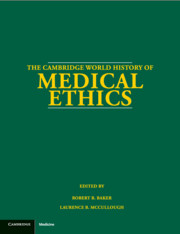Book contents
- Frontmatter
- PART I AN INTRODUCTION TO THE HISTORY OF MEDICAL ETHICS
- PART II A CHRONOLOGY OF MEDICAL ETHICS
- PART III DISCOURSES OF MEDICAL ETHICS THROUGH THE LIFE CYCLE
- 3 Medical Ethics through the Life Cycle in Hindu India
- 4 Medical Ethics through the Life Cycle in Buddhist India
- 5 Medical Ethics through the Life Cycle in China
- 6 Medical Ethics through the Life Cycle in Japan
- 7 Medical Ethics through the Life Cycle in Europe and the Americas
- 8 Medical Ethics through the Life Cycle in the Islamic Middle east
- PART IV THE DISCOURSES OF RELIGION ON MEDICAL ETHICS
- PART V THE DISCOURSES OF PHILOSOPHY ON MEDICAL ETHICS
- PART VI THE DISCOURSES OF PRACTITIONERS ON MEDICAL ETHICS
- PART VII THE DISCOURSES OF BIOETHICS
- PART VIII DISCOURSES ON MEDICAL ETHICS AND SOCIETY
- Appendix: Biographies: Who Was Who in the History of Medical Ethics
- Bibliography
- Index
8 - Medical Ethics through the Life Cycle in the Islamic Middle east
from PART III - DISCOURSES OF MEDICAL ETHICS THROUGH THE LIFE CYCLE
Published online by Cambridge University Press: 28 May 2012
- Frontmatter
- PART I AN INTRODUCTION TO THE HISTORY OF MEDICAL ETHICS
- PART II A CHRONOLOGY OF MEDICAL ETHICS
- PART III DISCOURSES OF MEDICAL ETHICS THROUGH THE LIFE CYCLE
- 3 Medical Ethics through the Life Cycle in Hindu India
- 4 Medical Ethics through the Life Cycle in Buddhist India
- 5 Medical Ethics through the Life Cycle in China
- 6 Medical Ethics through the Life Cycle in Japan
- 7 Medical Ethics through the Life Cycle in Europe and the Americas
- 8 Medical Ethics through the Life Cycle in the Islamic Middle east
- PART IV THE DISCOURSES OF RELIGION ON MEDICAL ETHICS
- PART V THE DISCOURSES OF PHILOSOPHY ON MEDICAL ETHICS
- PART VI THE DISCOURSES OF PRACTITIONERS ON MEDICAL ETHICS
- PART VII THE DISCOURSES OF BIOETHICS
- PART VIII DISCOURSES ON MEDICAL ETHICS AND SOCIETY
- Appendix: Biographies: Who Was Who in the History of Medical Ethics
- Bibliography
- Index
Summary
INTRODUCTION
The revelation of God in the Quran as the Holy Scriptures of Islam and the sayings of the Prophet not only contain statements about religious beliefs and duties, but also give meaning to each part of the life cycle. The content of such concepts as the beginning of life, childhood, illness, growing old, and death is constructed out of the faith and interpreted accordingly. These interpretations reveal themselves in corresponding rituals and ceremonies of everyday life, some of which go back to the time of the Prophet. This chapter discusses the interpretations of these stages of life that can be derived from Islamic sources and some medically relevant moral obligations that arise from them. To understand Islamic conceptions, one needs to comprehend certain pivotal texts and key terms. Much of this chapter therefore focuses on close readings of relevant texts (see also Chapter 17).
A sophisticated concern with the moral obligations of practitioners and patients is first found in the works of the ninth to fourteenth centuries of the Islamic Middle Ages. The main objective of medical practice in these works, in which the contribution of ancient authors is unmistakable, is to maintain and restore health. Scientific competence, medical skill, and moderation in all areas of life are the essential personal traits of practitioners. A patient is expected to protect himself from illnesses by means of preventive measures, search for a trustworthy practitioner in case of illness, and follow the instructions of his or her doctor.
- Type
- Chapter
- Information
- The Cambridge World History of Medical Ethics , pp. 163 - 172Publisher: Cambridge University PressPrint publication year: 2008



